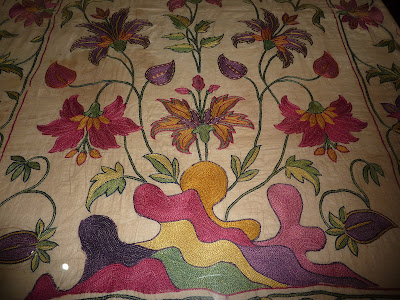Embroidery
Most people think of embroidery when they think of crafts in Kutch. Each of the dozens of communities in the region has a different style, passed down for generations (mostly) from mother to daughter. Particularly in nomadic communities, embroidery serves as a form of wealth that can be transported easily when the community moves. It is also a significant form of wealth brought as dowry when a girl gets married.
Historically, women embroidered everything from dowry bags to camel belts, but today fewer communities embroider. Some NGOs (such as Qasab, Kala Raksha, and Shrujan) are working to preserve traditional embroidery by hiring women to embroider items that might appeal to a broader audience, like purses and kurtas, using traditional techniques. Khamir doesn't work with embroidery because so many others do.
There are dozens of embroidery styles in Kutch, and you can read a pretty decent description of the communities and different styles here.
Styles of Embroidery
From December until March, my primary project was working on an exhibition highlighting textiles - mostly embroideries - from Kutch and it's neighbor, Sindh, now in Pakistan. It was a crash course in Kutchi communities, customs, and history. I worked with an excellent team of people composed of the head of my NGO, a recent NID graduate who had studied exhibition design, and A.A.Wazir, a local textile collector, in implementing the exhibition. I loved having people from all over the world come to Khamir to see the exhibition, and even got to practice French with some of them!
I have lots of information leftover from the exhibition, but won't bore you with it. Instead, I will just give you a basic sense of what it contained.
The Exhibition
 |
| Room One of the exhibition. |
 |
| Room Two of the exhibition. |
 |
| The collector, Wazir-bhai, showing off his pieces. |
 |
| This applique bed canopy is covered in sequins, representing stars, and is a design representing the universe. When you are laying and looking up at the canopy you are seeing the night sky. |
 |
| Bandhani (tie-dye) is a pretty complicated craft. I have been working on a piece of my own and it has taken me weeks just to do a small portion. |














Beautiful embroidery! The artisans of Kutch are truly skilled. Lovely post showcasing their craftsmanship! Taj Mahal Tour Packages From Delhi
ReplyDelete